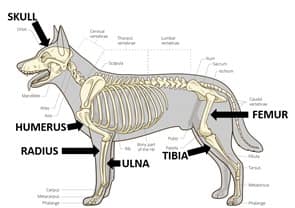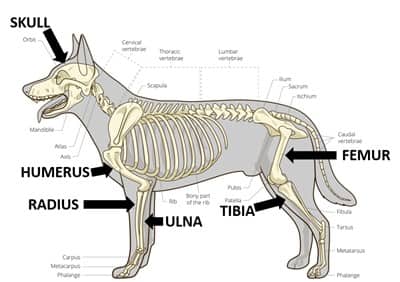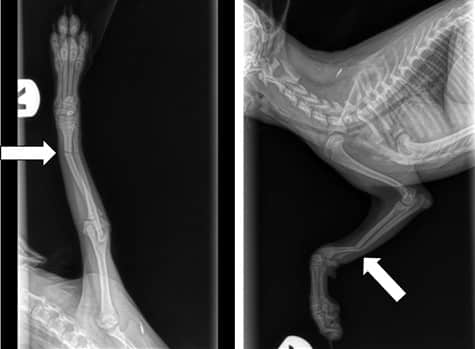Pomeranians and Broken Bones
Overview
A commonly overlooked care element for Pomeranians is the importance of taking steps to prevent bone fractures and breaks. Broken bones can be incredibly painful, take a long time to heal, and for Pomeranians and other toy breeds, are not overly rare occurrences.
This article will cover some surprising stats and facts about broken bones with Poms and vital steps to protect your Pomeranian from this sort of devastating injury. You’ll also meet a little cutie pie that suffered from two snapped bones in her leg from a seemingly common action and whose story serves as a cautionary tale.
Please note: PetPom is reader-supported, and some of the product suggestions on this page are affiliate links. As an Amazon Associate we earn from qualifying purchases. This is at no extra cost to you and helps keep this site running.
Overview of Pomeranian Skeletal System and Broken Bone Stats
Adult canines have between 319 and 321 bones; this number varies depending on how long a dog’s tail is. This can be compared to the 206 that adult humans have.
Out of all of the bones in a dog’s skeletal system, fractures and breaks are seen most often in the long weight-bearing bones in the limbs. This includes the humerus, radius and ulna bones found in the front legs and the femur and tibia bones found in the hind legs.
Which of these leg bones break the most often
depends on the size of the dog, though the #1 broken bone is not the femur (contrary to what some sources report).
Based on the medical records of 2.4 million dogs seen at one of the many Banfield Pet Hospitals across the US and summarized by Today’s Veterinary Practice, studies of broken bones with dogs
show that with toy breeds (dogs under 20 lbs.) the most commonly broken bone is the radius or ulna (9.9%), followed by the tibia (3.8%) and then the femur (3.4%). Other commonly broken bones include the skull (3.4%) and humerus (1.3%). Seen much less often is a broken spine (.4%), ilium (top of the pelvis/hips, .3%), and scapula (shoulder, .1%).
Note that due to the placement of the radius and ulna bones close together in the front legs, concurrent fractures of both bones are seen in the majority of cases.
Also note that the high rate of broken radius and/or ulna bones with toy breed dogs like the Pomeranian (9.9%) can be compared to the lower stats of just 5% with medium breeds, 3.9% with large breeds, and 4% with giant breeds.
The circumstances that lead to a dog breaking a bone
is also, to some degree, dependent on size. With large dogs, one of the most common reasons is being hit by a car. But, with small dogs, the top reasons for breaking a bone include falling out of an owner’s arms, being stepped on, and jumping down from a height.
Though PetPom has not conducted any formal studies or polls on this subject, based on communications with pet parents over the past decade, broken leg bones with Pomeranians occur most often from #1 jumping from heights and #2 wiggling free and inadvertently being dropped.
And, it may surprise you what qualifies as a ‘height’ for the Pomeranian.
Many Poms have suffered broken bones just when jumping down from their human’s bed and regular furniture such as a living sofa or chair. This typically shocks owners because it usually involved furniture that their Pom climbed up on and jumped down from hundreds of times in the past without issues.
In many cases, it is a matter of just landing ‘the wrong way’; though, repeated jumping can put stress onto ligaments and other supporting structures that, over time, weaken and underperform when controlling and assisting in the jump.
There are several factors that increase the risk of broken bones.
One is the landing surface. The risk of breaking a leg when jumping down from household furniture or falling from someone’s arms slightly increases if the floor is a hard surface (wood, tile, laminate) as opposed to carpeting.
Age is another factor. Puppies (1 year and younger) are much more prone to break bones due to their smaller structure and senior Pomeranians (8+ years) are also more at risk due to age-related bone loss and decreased traction. But it must be noted that the risk is still present for young adult Pomeranians.
Why It’s So Easy for a Pomeranian to Break a Leg
1. The actual drop can be dramatic.
Falling from the ‘height’ of furniture or a standing cuddle may not seem so perilous, until you take a look at the numbers.
For this, we’ll look a bit past the 8 to 11-inch height (floor to top of the shoulder blades) that is expected for Poms in the AKC show ring that are between 3 and 7 lbs. This is because many Pomeranians are actually slightly to moderately larger than this. In our comprehensive survey of 3,695 Pom owners, 29% reported that their Pom was over 10 lbs. (Note that the full survey results are included in PetPom’s GIANT Book of Pomeranian Care).
Since the reason behind larger-than-standard Pomeranians is usually due to bone structure as opposed to carrying excess weight, pet Pomeranians can be naturally taller than that 11-inch conformation limit, reaching 12 or 13 inches at the withers. With those slightly taller figures in mind, it's safe to say that the average height of pet Poms may be closer to the 10.5 inch range. And, this is the number that we’ll use in the following examples.
The height of sofa backs is usually in the 34 to 36 inch range. The median, 35 inches, is over 3 times the height of the average Pom and nearly 4 times the height of a young puppy. And the armrest can vary quite a bit from 26 to 38 inches; if you take the average, 32 inches, this is just over 3 times the height of an average adult Pom. If that doesn’t seem very extreme, consider that for a person that stands 5’5”, three times their height is 16.25 feet.
The range for seat heights of sofas is between 15 and 20 inches; this is usually not a problem for good-sized adults since they will just be dropping down just 1 and 1/2 times their height. But, for small puppies, this can be as much as 3 times their height.
What about falling from your arms? If you’re standing, this is a greater fall than from furniture. A person that’s 5’5” generally holds their pet at a height of 42 to 46”; an adult Pom that falls will drop four times their own height. If you have a puppy, if your Pomeranian is on the small side, or if you are taller than 5’5”, it’s even more of a dangerous tumble.
2. Pomeranians have more fragile bone structure than larger dogs.
Large dogs have large bones and small dogs have small bones. Pomeranians, Chihuahuas, and Yorkshire Terriers have some of the tiniest bones out of all canines. In addition, toy breeds do not have same strong supporting muscles seen with their larger counterparts.
The Story of Diva, a Pomeranian that Broke Her Leg by Jumping Off a Couch
When new Pom parent Lisa brought her new 3-month-old Pomeranian puppy home, she knew that it was important to do all she could to create a safe environment. She even asked her veterinarian a direct question about the possible danger of jumping down from furniture. Unfortunately, his professional and personal experience was that dogs know their limits and will not jump if it’s too high. In fact, the vet’s own small dog was accidently left on a bed and stayed there the entire day.
Lisa and Joe from Oceanside, NY with Diva on her first day home
Though Lisa knew that leaving her Pom on a bed wouldn’t happen, his advice made her feel better, “His story did at least make me feel a bit less paranoid if Diva was hanging out on the couch with either my boyfriend or I.”
But her Pomeranian proved that not all dogs are afraid to jump and tragedy can happen in a split-second.
At about 7 AM on the day that was supposed to be Diva’s first walk (puppy vaccinations were finally complete), Lisa was getting ready in her bedroom when she heard a bark and crying-type whimper.
“I ran into the living room and saw Diva on the floor with her leg broken. It appeared broken completely in half, under the skin. It was a horrific scene and a memory that I hope to soon forget, as the image is truly traumatizing. My boyfriend said that Diva was sitting on the couch (very hyper and playful) and jumped off over the armrest unexpectedly, hitting the hard wood floor.”
While Lisa comforted Diva, her boyfriend Joe frantically called the vet. Because the office was not yet open, they were instructed to go to an emergency pet hospital about 10 minutes away.
Her Pom was given pain medication and then anesthesia in order for x-rays to be taken. While Lisa and Joe sat in the waiting room for news regarding the treatment plan, surgery or a cast, they realized that this was not such an uncommon injury. “My boyfriend and I met another Pom owner with their 5-month-old Pomeranian, Lily, who had a cast on her right front leg after jumping off the bed, which is the same leg that Diva broke. I could not believe it! That Pomeranian was there for her follow up, and had previously gotten surgery where they had to insert a plate.”
Though Lisa planned on bringing Diva to her own vet for a second opinion, especially if surgery were recommended, at about 1:30 that afternoon she learned that some decisions were already made.
Diva’s leg was broken in two places.
Both the radius and ulna bones. This is not surprisingly since these are the most commonly broken bones for Pomeranians and other small dogs.
Diva's x-rays showing the complete breaks of her lower front leg bones, the radius and ulna.
There are 2 basic types of bone breaks
(also referred to as fractures): Incomplete (a partial break) and complete (the bone is broken through the entire circumference, creating two separate parts).
And, with complete breaks, there are 3 types:
Transverse (the break is straight across), oblique (the break is diagonal which creates sharp points), and comminuted (the bone is broken up into 3 or more fragments).
In addition, if there is no open wound on the skin this is referred to as a closed fracture. But, if the skin is broken and bone protrudes through, this is an open fracture.
Lisa’s Pomeranian had a closed complete slightly oblique break in both the radius and ulna.
The two main treatment options
for Pomeranians with complete bone breaks is a cast or surgery (a plate is screwed onto the bones to align them and help them properly fuse back together). Several factors come into play when making the decision including which bone is broken and the exact location of the fracture, the angle of the break, and a dog’s health status and age.
The veterinarian at the emergency hospital decided to place a cast on Diva while she was under the anesthesia.
The hope was that a hard cast placed on for an indeterminate time (with x-rays taken at two-week intervals to assess the healing process) would be as effective as a surgical plate. Given Diva’s young age, this was a possibility.
This adorable little Pom was sent home with Metacam (meloxicam) which is an NSAID used for pain and inflammation and a calcium supplement and her human was given a $2,000 bill.
In some cases, bed rest to restrict movement may be prescribed. But this was not the case with Diva. She was allowed to move around and was playful and full of energy the very next day, yet was very fearful of the wooden floor. And for good reason. A cast in contact with wood floors makes for a slick surface, and slipping around was painful. She did best on carpeting and soon learned to wiggle herself around, seemingly pain-free.
The typical recovery time
for a Pomeranian with a broken leg varies depending on the type of break, type of treatment, and the dog’s age. Young puppies usually heal faster than adults due to have more osteoblasts (bone-building cells) and there being less weight placed on the fracture. With Poms in general, a cast may need to stay on anywhere from 4 to 12 weeks.
With evaluations every two weeks, it was a total of 7 weeks before Diva’s case was removed. All things considered, she was extraordinarily lucky and had a very successful recovery.
Physical therapy may be needed in some cases to fully recover mobility.
For this little Pom puppy, just a bit more work was required to adjust to being cast-free. She wore a soft (removable) cast ending at the ankle for 10 days to allow her to get accustomed to her paw touching the ground. Her paw was massaged daily to stimulate the nerve endings during this time. Once those 10 days were complete, it took about one week for her to place her paw down and walk normally.
This little Pom went through a harrowing ordeal and is still afraid to walk on wooden floors. When we asked her human for any tips or tricks to help a Pomeranian heal from a broken leg, she offered, “I wish I had tips and tricks to share, but it’s really just having a ton of patience and giving your baby lots and lots of love!”
We’d like to thank Lisa for sharing her story and providing photos of her adorable little girl to help warn other Pom parents about this sort of danger.
How to Help Prevent Broken Bones
Diva’s story is just one of countless examples. Pomeranians are ‘under the foot’ dogs that can easily be accidently stepped on, may wiggle when in their human’s arms, can take tumbles down staircases, and may have zero fear when jumping from heights.
There are effective steps you can take to help keep your Pom safe from broken bones:
1.
Check your yard for any small holes or divots that your Pom could twist their leg in when running around outside. Examine the yard on a regular basis since wild animals, weather conditions, and other elements can create new obstacles. If you find any issues, fix them asap.
2.
Place gates across stairways or any areas of the house deemed potentially dangerous. This is particularly relevant for young puppies and older senior Pomeranians
that may have decreased sight and/or mobility.
3.
If you have hardwood, tile, or other flooring that your Pom tends to slip on obtain areas rugs. And, if you have a slippery staircase that cannot be gated off, place non-slip treads or non-slip tape like Clear Anti-Slip Indoor Strips by GRADE .
.
4.
Help your Pom have good traction by routinely massaging paw wax onto their paws. One like Musher's Secret Paw Protection Wax
 is excellent for helping dogs grip both indoor and outdoor surfaces, offers a layer of protection from both hot and cold surfaces, works to repel irritants and allergens and prevents and treats dry paw skin.
is excellent for helping dogs grip both indoor and outdoor surfaces, offers a layer of protection from both hot and cold surfaces, works to repel irritants and allergens and prevents and treats dry paw skin.
5.
Do not allow your Pomeranian to roughhouse with much larger dogs.
6.
Use caution when walking around any time that your Pom is freely roaming the house. Put on lights at night. Always look before opening and closing doors and taking turns around corners.
7.
If you do not yet have a designated area for your Pom, consider obtaining an indoor canine playpen like the IRIS Pet Playpen with Door
 . These are ideal for setting up an area when home alone to help prevent separation anxiety, it provides a safe sleeping area, and is an effective method of comfortably sequestering a dog for visitors, vacuuming, etc. Note that the 24" option is ideal for puppies and Poms on the small side and the 36" option is best for larger adults.
. These are ideal for setting up an area when home alone to help prevent separation anxiety, it provides a safe sleeping area, and is an effective method of comfortably sequestering a dog for visitors, vacuuming, etc. Note that the 24" option is ideal for puppies and Poms on the small side and the 36" option is best for larger adults.
8.
If your Pom has a history of jumping down off furniture, remember that 1000 safe landings may simply mean a run of good luck and that repeated hard landings can put wear and tear on joints, bones, and supporting tissue. Consider placing ramps or pet steps like the Pet Gear Easy Step II Pet Stairs - 2-Step
 against your Pom’s favorite spot on a couch or chair and offer praise and reward to reinforce the idea of using them.
against your Pom’s favorite spot on a couch or chair and offer praise and reward to reinforce the idea of using them.
Note that Pet Gear's stairs are incredibly sturdy, holding weights of up to 75 lbs., but are sized for toy dogs. And, if your Pomeranian like to leap off your bed, you may want to consider their 3-step option.
9.
You, and anyone else allowed to hold your Pom, should only do so if there will be no multitasking. A Pomeranian should always be held close to your body with two hands; one hand under the rump and the other on the chest. The hold should be firm and supportive.
10.
Do not let children hold your Pom unless they are old enough and responsible enough to understand and follow the protocol for safe handling.
11.
The best way to keep a dog’s bones strong is to offer a wholesome and healthy meal plan with a top-quality kibble
and keep your Pom active with regular exercise. Note that if you are feeding your Pom a superior dog food, extra calcium supplements are not usually needed. These are typically reserved for dogs that are fed homecooked meals and may be given as part of a treatment plan in the case of a broken bone.
You May Also Like:
Pomeranian Winter Care
- Keeping a Pom safe and happy throughout the cold winter months. Covers handling walks in the snow, staying warm despite freezing temps, counteracting the effects of super-arid air, and other common wintertime obstacles.
How to Keep a Pomeranian Safe
- The top 15 ways to keep your Pom super safe. How many are you doing?
Pomeranian is Scared of Loud Noises
- From thunder to fireworks and even the vacuum cleaner, some dogs are terribly afraid of loud sounds; learn why this is and exactly how to help your little guy or gal.
How to Fix Tear Stains on a Pomeranian
- If your Pom has discoloration under or around the eyes, it'll take a bit of work but these can be fully removed.














